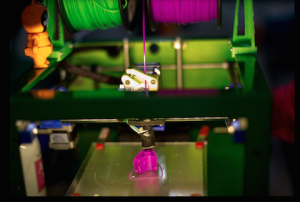Making Math 3D
It is officially Mathematics Awareness Month, the perfect time to highlight what is making math more accessible and more real for students. 3D printers are definitely evolving into a essential tool for mastering mathematics in the 21st Century. In honor of the month, we are taking the opportunity to find out why.
When I think of 3D printers, I am instantly taken back to the days of George Jetson, imagine pressing a button and opening a magic door to exactly what I had asked for. Honestly, the 3D printing technology seems frighteningly close to that futuristic memory, but, the truth is, there is HUGE potential for 3D printing to impact math education in a variety of ways.
The Process. The idea of how 3D printing works is a math lesson in itself. Being a total novice in this department I calledCasey Hopkins, Founder of Elevation Lab. Hopkins uses a 3D printer to build product prototypes and was able to help me visualize the process – think of a tube of toothpaste or a hot glue gun, building layer upon layer until the desired object is created. Not to oversimplify, but in attempt to gain a very basic understanding of what is happening within these machines, he explained the process so that I could brainstorm classroom connections. It really breaks down to:
-
The individual gives the machine a detailed set of instructions through the use of computer software (often including algebraic equations as instructions).
-
The printer uses these instructions to create layers that build upon one another to construct the final project (think of building a ball by carefully stacking cut out circles of different shapes).
-
In order to build more complex items, the software provides more complex instructions (and therefore more complex math to review with students).
The Mathematics. As you might have guessed, the math teacher in me can’t help but immediately think about how I would use this idea in the classroom, and the truth is there are a number of ways that a 3D printer can advance students conceptual understanding of fundamental and complex mathematics:
-
Functions – A 3D printer really is a perfect example of an input/output. Why not use the idea to help students understand the role of a function in mathematics?
-
Algebraic Equations – We can take the idea of a function one step further and look into exactly what equations are used in the computer software that builds instructions for these printers. If we want the printer to build a circle, what sorts of equations might we use in our instructions?
-
Recursive Formulas – This type of formula uses the preceding term to define the next term of the sequence. They may use the same formula but because they start with a different input, they result in different patterns.
-
(x,y,z) Coordinates – The final printed product is made up of a network of these coordinates that help to create the structure of the object.
-
Intersecting a plane with solid objects – When you intersect a plane with a cube, what do you get? Now think instead of building that cube out of a series of squares. Why not use the process of 3D printing to expand on this idea, better yet let the students research 3D printing and explain the process to you.
Mathematical Modeling. As I continued to research this idea, I wondered how else these printers would impact the classroom. For my continued education, I called our friend Dr. Matthew Peterson at MIND Research Institute. MIND Research is actively working on building 3D manipulatives that work with their Spatial Temporal (ST) Math software, helping “make math come to life even more so than with the software alone.”
MIND Research is currently piloting a program now that provides teachers with the software for a variety of manipulatives that are embedded into the ST Math program. Dr. Peterson explains that he has been looking at how to do manipulatives for a long time, “it adds a lot of flexibility and instant access into the physical world from a digital content.” MIND continues to research when and how to incorporate manipulates effectively to bridge between the physical and virtual world.
3D printing provides a more efficient model for a variety of classroom manipulatives. Most importantly, you can print out exactly each student needs. Gone are the days of purchasing full class sets and shipping them from around the world. If you have 30 kids that each need a hands on experience for different concepts, then you can easily personalize the learning experience for everyone of them. If you lose one piece, you won’t have to get a whole new set, you can instantly print just what you need. New technologies will allow you to recycle within the 3D printing machine, helping cut down on waste.
As the world around us continues to change, we need to look at how we introduce kids to new technologies and innovation. The 3D printer and other tools like it are creating more and more teachable moments for us and our students. Lets make sure we utilize these opportunities to help prepare students for careers of the future.


